| Image | Common name | Scientific name | Distribution |
|---|
 | Scott's oriole | Icterus parisorum | Southwestern United States and south to Baja California Sur and central Mexico. |
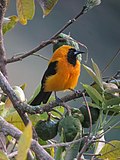 | Yellow-backed oriole | Icterus chrysater | Belize, Colombia, El Salvador, Guatemala, Honduras, Mexico, Nicaragua, Panama, and Venezuela. |
 | Audubon's oriole | Icterus graduacauda | westernmost range extends from Nayarit south to southern Oaxaca, whereas the eastern range stretches from the lower Rio Grande valley to northern Querétaro |
 | Jamaican oriole | Icterus leucopteryx | Jamaica and on the Colombian island of San Andrés |
 | Orange oriole | Icterus auratus | the Yucatán Peninsula and far northern Belize |
 | Altamira oriole | Icterus gularis | subtropical lowlands of the Mexican Gulf Coast and northern Central America, the Pacific coast and inland |
 | Yellow oriole | Icterus nigrogularis | northern South America in Colombia, Venezuela, Trinidad, the Guianas and parts of northern Brazil, (northern Roraima state, and eastern Amapá) |
 | Bullock's oriole | Icterus bullockiorum | as far north as British Columbia in Canada and as far south as Sonora or Durango in Mexico |
 | Streak-backed oriole | Icterus pustulatus | Costa Rica, Nicaragua, Honduras, El Salvador, Guatemala, Mexico and an occasional visitor to the Southwestern United States |
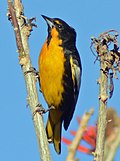 | Black-backed oriole | Icterus abeillei | Mexico. |
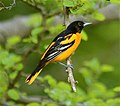 | Baltimore oriole | Icterus galbula | Canadian Prairies and eastern Montana in the northwest eastward through southern Ontario, southern Quebec and New Brunswick and south through the eastern United States to central Mississippi and Alabama and northern Georgia. |
 | Yellow-tailed oriole | Icterus mesomelas | southern Mexico to western Peru and northwestern Venezuela |
 | Spot-breasted oriole | Icterus pectoralis | Costa Rica, El Salvador, Guatemala, Honduras, Mexico, and Nicaragua. |
 | White-edged oriole | Icterus graceannae | Ecuador and Peru. |
 | Campo troupial | Icterus jamacaii | northeastern Brazil |
 | Venezuelan troupial | Icterus icterus | Colombia, Venezuela, and the Caribbean islands of Aruba, Curaçao, Bonaire, and Puerto Rico. |
 | Orange-backed troupial | Icterus croconotus | Guyana, Brazil, Paraguay, and eastern Ecuador, Bolivia, and Peru |
 | Bar-winged oriole | Icterus maculialatus | El Salvador, Guatemala, Honduras, and Mexico. |
 | Black-vented oriole | Icterus wagleri | El Salvador, Guatemala, Honduras, Mexico, Nicaragua, and the United States. |
 | Hooded oriole | Icterus cucullatus | Baja California Sur, the Mexican east coast, and Belize. |
 | Black-cowled oriole | Icterus prosthemelas | eastern half of mainland Central America. |
 | Orchard oriole | Icterus spurius | United States, Mexico |
 | Cuban oriole | Icterus melanopsis | island of Cuba and the neighboring Isla de la juventud |
 | Bahama oriole | Icterus northropi | the Bahamas. |
| Martinique oriole | Icterus bonana | Martinique, French West Indies |
 | Puerto Rican oriole | Icterus portoricensis | Puerto Rico |
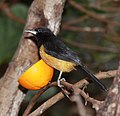 | Montserrat oriole | Icterus oberi | Lesser Antilles of the West Indies, |
| Saint Lucia oriole | Icterus laudabilis | main island of St. Lucia |
 | Hispaniolan oriole | Icterus dominicensis | Hispaniola. |
 | Orange-crowned oriole | Icterus auricapillus | eastern Panama, Colombia and Venezuela. |
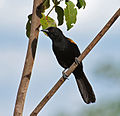 | Variable oriole | Icterus pyrrhopterus | Argentina, Bolivia, Brazil, Paraguay, and Uruguay. |
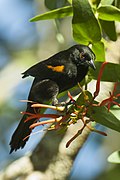 | Epaulet oriole | Icterus cayanensis | Bolivia, Brazil, Colombia, Ecuador, French Guiana, Guyana, Peru, and Suriname. |
|






























